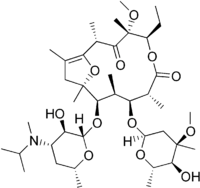Mitemcinal
Mitemcinal (GM-611 or 3'-N-dimethyl-11-deoxy-3'-N-isopropyl-12-O-methyl-11-oxo-8,9-didehydroerythromycin) is a motilin agonist derived from the macrolide antibiotic, erythromycin. It was discovered in the labs of Chugai Pharma. Mitemcinal is orally administered and it is believed to have strong promotility (or prokinetic) effects. Promotility drugs relieve symptoms of reflux by speeding the clearance of acid from the oesophagus and stomach.[1] The parent compound, erythromycin, has these characteristics, but mitemcinal lacks the antibiotic properties of erythromycin.[2]
 | |
| Names | |
|---|---|
| IUPAC name
(1R,2R,3S,4S,5R,8R,9R,11S)-8-ethyl-4-[(2R,4R,5S,6S)-5-hydroxy-4-methoxy-4,6-dimethyloxan-2-yl]oxy-2-[(2S,3R,4S,6R)-3-hydroxy-6-methyl-4-[methyl(propan-2-yl)amino]oxan-2-yl]oxy-9-methoxy-1,3,5,9,11,13-hexamethyl-7,15-dioxabicyclo[10.2.1]pentadec-12-ene-6,10-dione | |
| Other names
Mitemcinal, GM-611 | |
| Identifiers | |
CAS Number |
|
3D model (JSmol) |
|
| ChemSpider | |
PubChem CID |
|
| UNII | |
InChI
| |
SMILES
| |
| Properties | |
Chemical formula |
C40H69NO12 |
| Molar mass | 755.98 g/mol |
Except where otherwise noted, data are given for materials in their standard state (at 25 °C [77 °F], 100 kPa). | |
| Infobox references | |
Presently, erythromycin is commonly used off-label for gastric motility indications such as gastroparesis. If mitemcinal can be shown to be as effective a promotility agent, it would represent a significant advance in the GI field as treatment with this drug would not carry the risk of unintentional selection of antibiotic-resistant bacteria. This concept greatly intrigued Chugai, and the company pursued it as an ideal candidate for a long-term prokinetic agent to treat lower gastrointestinal deficiencies including gastroparesis.[3]
The Phase II trials did not detect an increase in gastric emptying among the population of diabetic gastroparesis patients above placebo.[4] Thus, although Chugai was able to demonstrate the required safety of the compound, development of this drug has stalled due to a lack of convincing efficacy data.
Notes and references
- Promotility agents
- Karamanolis G, Tack J (2006). "Promotility medications—now and in the future". Dig Dis. 24 (3–4): 297–307. doi:10.1159/000092883. PMID 16849857.
- Ozaki K, Yogo K, Sudo H, et al. (2007). "Effects of mitemcinal (GM-611), an acid-resistant nonpeptide motilin receptor agonist, on the gastrointestinal contractile activity in conscious dogs". Pharmacology. 79 (4): 223–35. doi:10.1159/000101537. PMID 17426410.
- The Conclusion of the cited reference does not indicate that there was no benefit. On the contrary, the study said there was an increase in gastric emptying. McCallum RW, Cynshi O (Oct 2007). "Clinical trial: effect of mitemcinal (a motilin agonist) on gastric emptying in patients with gastroparesis - a randomized, multicentre, placebo-controlled study". Aliment. Pharmacol. Ther. 26 (8): 1121–30. doi:10.1111/j.1365-2036.2007.03461.x. PMID 17894654.